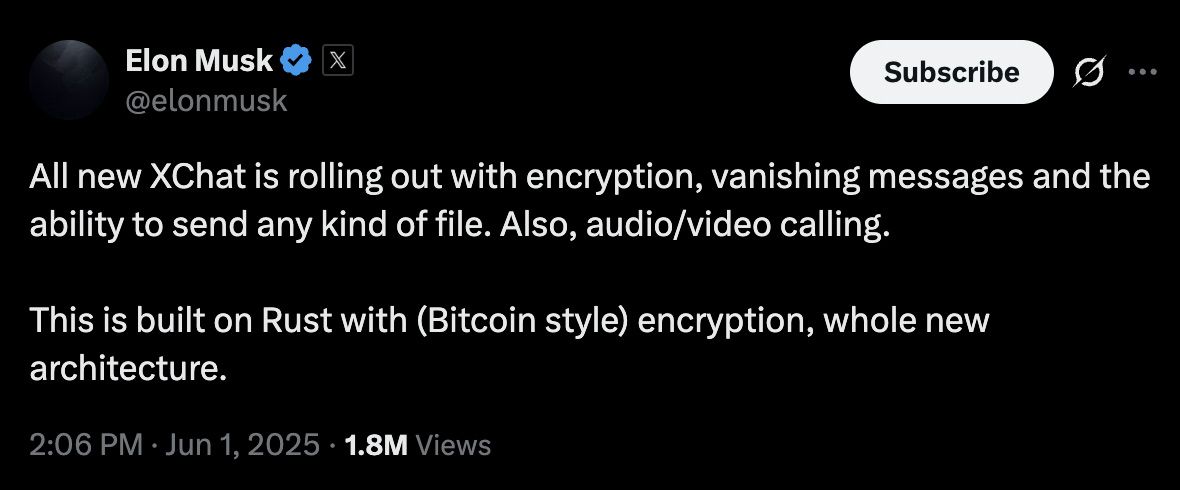With encrypted messaging, vanishing texts, cross-platform calling, and Bitcoin-style architecture, X just took a step toward something bigger. This isn’t just a feature drop. It’s a direction.
XChat’s rollout didn’t come with a flashy product video or a Silicon Valley demo stage. It arrived, as many things from Elon Musk do, via a post on X. But behind the casual delivery is something more deliberate.

Encrypted messages. Vanishing texts. File transfers. Audio and video calls without a phone number. And under the hood, a new architecture written in Rust with what Musk calls “Bitcoin-style encryption.”
Taken on its own, it’s a solid product update. But viewed in context—especially with the long-anticipated X Payments infrastructure on the horizon—it starts to feel like a larger structural shift. XChat may not just be a better way to DM. It may be the first visible surface of a deeper realignment of X itself.
Rewriting the Stack
The most interesting thing about the suggested XChat won’t be the interface—it’s the architecture. Musk said it was built in Rust, a modern language known for security and performance, and that the app operates on a new backend separate from legacy Twitter code.
This matters. The codebase of any mature social platform is often a tangle of legacy logic, rushed patches, and incremental tweaks. Starting from scratch allows for control. It opens the door to better encryption, lower latency, and new models of identity.
It also signals something larger: X may be evolving from a social media platform into a full-stack infrastructure layer for communication and commerce. If that’s the goal, the foundation has to be clean. And this may be the first real piece of it.
Bitcoin-Style Encryption as a Design Philosophy
The phrase “Bitcoin-style encryption" suggests that what’s being built isn’t merely encrypted, but philosophically aligned with the core principles of Bitcoin—trust minimization, decentralization, and user control.
Whether XChat fully adheres to those values remains to be seen. But invoking that architecture implies a vision. One where users don’t just send messages, but do so without needing to trust the company that built the app. One where identity is persistent across services but owned by the user, not the platform.
If X moves in this direction, it would represent a fundamental break from the current model of social media and messaging—one where every platform is siloed, every identity fragmented, and every message stored indefinitely in someone else’s cloud.
No Phone Number, No Borders
One of the more subtle but powerful shifts in XChat is its independence from phone numbers. That’s a move away from the SIM-card-rooted identity system that underpins most messaging platforms today.
By removing phone numbers from the equation, X is signaling a more fluid, global identity layer—one less tied to geography or carriers. This sets the stage for interoperable communication, but also for something else: global commerce.
If X Payments launches with a similar architecture, one tied not to banks or carriers but to usernames and wallets, the implications become clearer. You message. You call. You pay. All within the same self-contained system. And that system doesn’t care where you live or what your carrier is.
Messaging as Infrastructure
It’s easy to look at encrypted DMs and vanishing messages as incremental features. But when you consider the roadmap that X is slowly sketching—media, payments, messaging, commerce—it begins to resemble something more: an operating system for interaction.
And the architecture behind it matters. Bitcoin-style encryption isn’t just about keeping your chats private. It’s about establishing a framework where users can transact, share, and connect without being constantly surveilled, monetized, or locked into opaque systems.
It’s a way of saying: the rails matter. And they’re being rebuilt.
What Comes After Messaging
If X is rebuilding its stack around private communication and financial interaction, it may end up looking less like a social network and more like an infrastructure protocol that happens to have a public interface.
That’s a quiet but powerful transformation. It changes how users relate to the platform—and how the platform relates to its users. Less of a stage, more of a tool. Less performative, more transactional.
And while the transition won’t be clean or immediate, the architecture tells the story. Messaging comes first. Payments come next. And if it all fits together as imagined, X may just become the everything app Musk has long aspired to.



